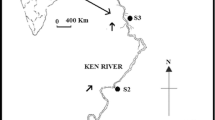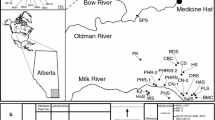Abstract
Sub-fossil insect remains have the potential to characterise changing environmental conditions in both lentic and lotic water systems, however, relatively few studies have been undertaken in riverine environments. This paper uses sub-fossil caddisfly larvae (Trichoptera) and aquatic beetles (Coleoptera) to reconstruct river flow conditions for a large paleochannel (from multiple monoliths) using the Lotic invertebrate Index for Flow Evaluation (LIFE). Examination of the larval Trichoptera and Coleoptera remains indicated a marked change in the community and flow environment, as suggested by paleoLIFE scores within the profile of three of the monoliths examined. At the base of the channel the community was characterised by taxa indicative of high energy lotic habitats with predominantly mineral substrates (e.g. Trichoptera: Hydropsyche contubernalis and Brachycentrus subnubilis, Coleoptera: Elmis aenea and Esolus parallelepipedus). Within three of the monoliths there was a change in community composition to one indicative of a low energy backwater/lentic environment with abundant submerged and emergent vegetation (e.g. Trichoptera: Phryganea bipunctata and Limnephilus flavicornis, Coleoptera: Colymbetes fuscus and Hydrobius fuscipes). Detrended Correspondence Analysis (DCA) and loss of mass on ignition (LOI) indicated the presence of a strong environmental gradient within the data, associated with river flow. The utilisation of two aquatic insect orders provides clear evidence of temporal changes within the instream community and when combined with knowledge of ecological and habitat associations, allows differences between the two groups to be interpreted more clearly.


Similar content being viewed by others
References
Bacher I, Waringer JA (1996) Hydraulic microdistribution of cased caddis larvae in an Austrian mountain brook. Int Rev Hydrobiol 81:541–554
Balfour-Browne F (1950) British water beetles II. Ray Society, London, 394 pp
Barnard PC (1985) An annotated check-list of the Trichoptera of Britain and Ireland. Entomol Gaz 36:31–45
Brown AG (1996) Floodplain Paleoenvironments. In: Anderson MG, Walling DE, Bates PD (eds) Floodplain processes. Wiley, Chichester, pp 95–138
Brown AG, Keough MK, Rice RJ (1994) Floodplain evolution in the East Midlands, United Kingdom: the Lateglacial and Flandrian alluvial record from the Soar and Nene valleys. Philos T R Soc A. 348:261–293. doi:10.1098/rsta.1994.0091
Brown AG, Cooper L, Salisbury CR, Smith DN (2001) Late Holocene channel changes of the Middle Trent—channel response to a thousand—year flood record. Geomorphology 39:69–82. doi:10.1016/S0169-555X(01)00052-6
Buckland PI and Buckland PC (2006) Bugs Coleopteran Ecology package Software [Component versions: Bugs CEP: Release 7.43; Bugsdata: Release 7.09; Bugs MCR: Release 2.0; Bustats: Release 1.2] (Downloaded/CDROM:Oct 2006)
Castella E, Richardot-Coulet M, Roux C, Richoux P (1984) Macroinvertebrates as describers of morphological and hydrological types of aquatic ecosystems abandoned by the Rhone River. Hydrobiologia 119:219–225. doi:10.1007/BF00015212
Clews E, Ormerod SJ (2009) Improving bio-diagnostic monitoring using simple combinations of standard biotic indices. River Res Appl. doi:10.1002/rra.1166
Coope GR (1986) Coleoptera analysis. In: Berglund BE (ed) Handbook of Holocene Paleoecology and Paleohydrology. John Wiley and Sons, Chichester, pp 703–713
Davis SR, Brown AG, Dinnin MH (2007) Floodplain connectivity, disturbance and change: a paleoentomological investigation of floodplain ecology from south-west England. J Anim Ecol 76:276–288. doi:10.1111/j.1365-2656.2006.01209.x
Dean WE (1974) Determination of carbonate and organic matter in calcareous sediments and sedimentary rocks by loss on ignition: comparison with other methods. J Sediment Petrol 44:242–248
Duff A (2008) Checklist of beetles of the British Isles. G. G. Duff, Somerset, 166 pp
Edington JM, Hildrew AG (1995) Caseless caddis larvae: a key with ecological notes, 2nd edn. Freshwater Biological Association, Ambleside, 134 pp
Elias SA (1994) Quaternary insects and their environments, 1st edn. The Smithsonian Institution, Washingto, 284 pp
Extence CA, Balbi DM, Chadd RP (1999) River flow indexing using British benthic macroinvertebrates: a framework for setting hydroecological objectives. Regul River 15:543–574. doi:10.1002/(SICI)1099-1646(199911/12)15:6<545::AID-RRR561>3.0.CO;2-W
Friday LE (1988) A key to the adults of British Water beetles. Dorset Press, Dorcheste, 125 pp
Greenwood MT, Smith DN (2005) Changing fluvial conditions and landscapes in the Trent valley: a review of paleoentomological evidence. In: Smith DN, Brickley MB, Smith W (eds) Fertile ground: papers in honour of Susan Limbrey. Oxbow books, Oxford, pp 53–67
Greenwood MT, Agnew MD, Wood PJ (2003) The use of caddisfly fauna (Insecta: Trichoptera) to characterise the Late-Glacial river Trent, England. J Quat Sci 18:645–661. doi:10.1002/jqs.786
Greenwood MT, Wood PJ, Monk WA (2006) The use of fossil caddisfly assemblages in the reconstruction of flow environments from floodplain paleochannels of the River Trent, England. J Paleolimnol 35:747–761. doi:10.1007/s10933-005-5162-6
Hansen M (1987) The Hydrophiloidea (Coleoptera) of Fennoscandia and Denmark. Brill, Leiden, 254 pp
Harde KW (1998) A field guide in colour to Beetles, 2nd edn. Blitz Editions, Leiceste, 334 pp
Hickin NE (1967) Caddis larvae: larvae of the British Trichoptera. Hutchinson, London, 480 pp
Hiley PD (1973) The taxonomy of certain caddis-fly larvae: together with an investigation into factors limiting the distribution of selected species. Ph.D. thesis, University of Newcastle upon Tyne, Newcastle upon Tyne, 204 pp
Hiley PD (1976) The identification of the British limnephilid larvae (Trichoptera). Syst Entomol 1:147–167. doi:10.1111/j.1365-3113.1976.tb00346.x
Holmen M (1987) The aquatic Adephaga (Coloeoptera) of Fennoscandia and Denmark. Brill, Leiden, 168 pp
Howard AJ (2005) The contribution of geoarchaeology to understanding the environmental history and archaeological resources of the Trent valley, UK. Geoarchaeology 20:93–107. doi:10.1002/gea.20038
Howard AJ, Bridgland D, Knight D, McNabb J, Rose J, Schreve D, Westaway R, White MJ, White TS (2007) The British Pleistocene fluvial archive: East Midlands drainage evolution and human occupation in the context of the British and NW European record. Quat Sci Rev 26:2724–2737. doi:10.1016/j.quascirev.2007.06.029
Lemdahl G (2000) Late-glacial and early Holocene Coleoptera assemblages as indicators of local environment and climate at Kråkenes Lake, W. Nor J Paleolimnol 23:57–66. doi:10.1023/A:1008012830139
Lewin J, Macklin MG, Johnstone E (2005) Interpreting alluvial archives: sedimentological factors in the British Holocene fluvial record. Quat Sci Rev 24:1873–1889. doi:10.1016/j.quascirev.2005.01.009
Lowe JJ, Walker MJC (1997) Reconstructing Quaternary Environments, 2nd edn. Pearson Education, Harlow, Essex
Lytle DA, Poff NL (2004) Adaptation to natural flow regimes. Trends Ecol Evol 19:94–100. doi:10.1016/j.tree.2003.10.002
Merritt R (2006) Atlas of the water beetles (Coleoptera) and water bugs (Hemiptera) of Derbyshire, Nottinghamshire and South Yorkshire, 1993–2005, Sorby Record Special Series, 14th edn, 160 pp
Monk WA, Wood PJ, Hannah DM, Wilson DA (2008) Macroinvertebrate community response to inter-annual and regional river dynamics. River Res Appl 24:988–1001. doi:10.1002/rra.1120
Monk WA, Wood PJ, Hannah DM, Wilson DA, Extence CA, Chadd RP (2006) Flow variability and macroinvertebrate community response within riverine systems. River Res Appl 22:595–615. doi:10.1002/rra.933
Nilsson AN, Holmen M (1995) The aquatic Adephaga (Coleoptera) of Fennoscandia and Denmark II. In: Brill EJ (ed) Dytiscidae, 32nd edn. Fauna Entomologica Scandinavica, Leiden, 192 pp
Olden JD, Hoffman AL, Monroe JB, Poff NL (2004) Movement bahaviour and dynamics of an aquatic insect in a stream benthic landscape. Can J Zool 82:1135–1146. doi:10.1139/z04-094
Osborne PJ (1988) A late bronze age insect fauna from the river Avon, Warwickshire, England: its implications for the terrestrial and fluvial environment and for climate. J Archaeol Sci 15:715–727. doi:10.1016/0305-4403(88)90061-1
Paillex A, Castella E, Carron G (2007) Aquatic macroinvertebrate response along a gradient of lateral connectivity in river floodplain channels. J N Am Benthol Soc 26:779–796. doi:10.1899/06-12.1
Ponel P, Coope GR, Antoine P, Limondin-Lozouet N, Leroyer C, Munaut A, Pastre J, Guiter F (2005) Lateglacial paleoenvironments and paleoclimates from Conty and Houdancourt, northern France, reconstructed from Beetle remains. Quat Sci Rev 24:2449–2465. doi:10.1016/j.quascirev.2004.12.010
Salisbury CR (1992) The archaeological evidence for palaeochannels in the Trent valley. In: Needham S, Macklin MG (eds) Alluvial archaeology in Britain. Oxbow books, Oxford, pp 155–162
Smith DN, Howard AJ (2004) Identifying changing fluvial conditions in low gradient alluvial archaeological landscapes: can Coleoptera provide insights into changing discharge rates and floodplain evolution? J Archaeol Sci 31:109–120. doi:10.1016/j.jas.2003.07.002
Smith DN, Roseff R, Butler S (2001) The sediments, Pollen, Plant Macro-fossils and insects from a bronze age channel fill at Yoxall Bridge, Staffordshire. Environ Archaeol 6:1–12
Smith DN, Roseff R, Bevan L, Brown AG, Butler S, Hughes G, Monckton A (2005) Archaeological and environmental investigations of a lateglacial and Holocene river sedimentary sequence on the river Soar at Croft, Leicestershire, UK. Holocene 15:353–377. doi:10.1191/0959683605hl806rp
Solem JO, Birks HH (2002) Late glacial and early Holocene Trichoptera (Insecta) from Kråkenes Lake Western Norway. What Trichoptera fossil remains tell us about climatic changes? Proceedings 10th International Symposium on Trichoptera, Nova Supplemanta Entomologica Keltern, pp 75–80
ter Braak CJF, Šmilauer P (2002) CANOCO reference manual and users guide to Canoco for Windows: software manual for Canonical Community Ordination (version 4.5). Micro-computer Power, Ithaca, 500 pp
Urbanič G, Toman MJ, Krusnik C (2005) Microhabitat type selection of caddisfly larvae (Insecta: Trichoptera) in a shallow lowland stream. Hydrobiologia 541:1–12. doi:10.1007/s10750-004-4314-4
Wallace ID (1980) The identification of British Limnephilid larvae (Trichoptera: Limnephilidae) which have single filament gills. Freshw Biol 10:171–189. doi:10.1111/j.1365-2427.1980.tb01191.x
Wallace ID, Wallace B, Philipson GN (2003) Keys to the case bearing caddis larvae of Britain and Ireland. Freshwater Biological Association, Ambleside, 259 pp
Wiberg-Larsen P, Brodersen KP, Birkholm S, Grøns PN, Skriver J (2000) Species richness and assemblage structure of Trichoptera in Danish streams. Freshw Biol 43:633–647. doi:10.1046/j.1365-2427.2000.00546.x
Williams NE (1988) The use of caddisflies (Trichoptera) in paleoecology. Palaeogeogr Palaeoclimatol Palaeoecol 62:493–500. doi:10.1016/0031-0182(88)90069-7
Acknowledgments
We thank Hanson plc for access to the site and the continued co-operation and assistance of Birmingham Archaeology throughout this project is gratefully acknowledged. LCH acknowledges the support of Research Studentship Award from the Department of Geography at Loughborough University. We would like to thank all those at Loughborough University who have helped along the way and in particular Dr. Wendy Monk and Clare Blake. Special thanks go to Dr. Chris Salisbury, Dr. David Smith, Dr. Andy Howard, Mrs Helen Martin-Bacon, Dr. Emma Tetlow and Dr. Richard Cutler for help and advice throughout the project. Funding for radiocarbon dates was provided by the Department of Geography at Loughborough University, Birmingham Archaeology and Michael Fairfield. Thanks also to Mark Szegner for preparation of the figures for publication.
Author information
Authors and Affiliations
Corresponding author
Rights and permissions
About this article
Cite this article
Howard, L.C., Wood, P.J., Greenwood, M.T. et al. Reconstructing riverine paleo-flow regimes using subfossil insects (Coleoptera and Trichoptera): the application of the LIFE methodology to paleochannel sediments. J Paleolimnol 42, 453–466 (2009). https://doi.org/10.1007/s10933-008-9298-z
Received:
Accepted:
Published:
Issue Date:
DOI: https://doi.org/10.1007/s10933-008-9298-z




